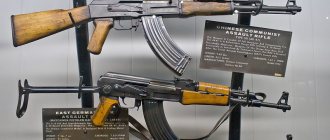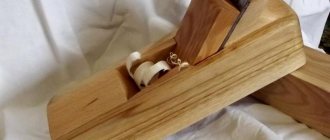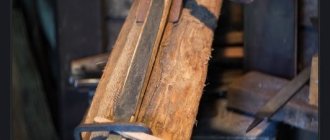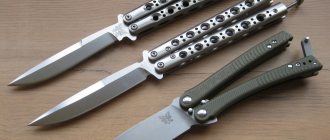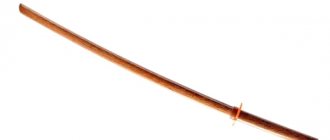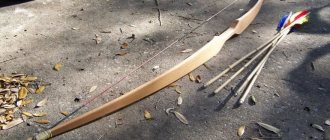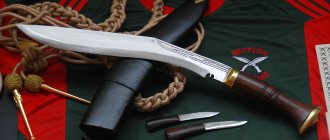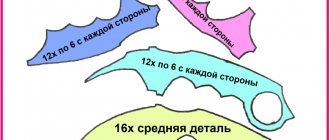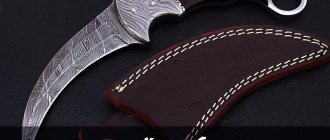Snowmobiles are self-propelled vehicles designed for movement across snow-covered fields and frozen bodies of water. Externally, these vehicles are similar to motorized snowmobiles, but differ from them in design and method of movement. A snowmobile is designed like a motorcycle, but instead of wheels it has a driving track. The snowmobile is completely mounted on runner skis, and the propeller function is performed by a propeller. By sliding on snow or ice, the equipment accelerates to 150 km/h, and in terms of cross-country ability, such vehicles are considered unrivaled. Thanks to these properties, they are in demand among lovers of hunting, fishing, and active winter recreation. Snowmobiles can be used by various services to deliver people and cargo to hard-to-reach areas, search and rescue operations, and patrol areas.
Story
The active design and production of snowmobiles began at the beginning of the 20th century. Developments were carried out in many countries: Germany, France, Austria, but the greatest successes were achieved by domestic inventors. In 1904, the first model of a self-propelled sleigh with an aircraft propeller designed by Sergei Nezhdanovsky was demonstrated in Russia. It was an exhibition sample, not very suitable for practical use. However, it became the starting point for the subsequent development of the industry. Already in 1907, the Moscow DUKS plant put Yuri Meller's ski cars into production. The vehicles were equipped with 3.5 hp engines. and could accelerate to 16.5 km/h. And in 1912, the world saw the pinnacle of engineering: the device created by Igor Sikorsky could reach speeds of up to 75 km/h, which at that time seemed simply unrealistic. The same period saw the introduction of a number of developments that are relevant to this day. This is the equipment of the machine with a cabin, a system for transmitting rotation of the motor shaft to the propeller, and a device for changing the thrust vector.
After the October Revolution, developments were actively carried out to create snowmobiles for both civil and military purposes. A landmark event occurred in 1961, when the Tupolev Design Bureau developed a model of the A-3 amphibious snowmobile. In fact, it became the first airboat in the Soviet Union. Equipped with a 260-horsepower engine, the planing machine could move on water at a speed of 80 km/h, and on snow and ice - 100 km/h, easily overcoming small obstacles. Currently, Russian manufacturers produce a large range of snowmobiles and amphibious airboats for transporting passengers and cargo. The largest of them have a carrying capacity of up to 1.5 tons.
Device
The design of the snowmobile is quite simple. Its main elements are:
- frame;
- engine:
- air propeller.
The body is a metal frame supported by 3 or 4 skis. The most common scheme is with three runners. Cars with four skis are more stable and have better maneuverability on loose snow, but their design is more labor-intensive. Amphibious vehicles are made without skids and have the shape of a flat-bottomed boat. When moving, they rely on the body. To protect against friction, he is dressed in abrasion-resistant armor. Typically, supermolecular polyethylene grades PE 500, PE 1000 are used. This is a slippery material, which, for example, is used in the production of artificial ice for skating rinks. Ceramoplast has even better properties, but it is significantly more expensive. Since snowmobiles are used in the cold season, many models have a heated cabin.
Internal combustion engines are used as the power unit. Depending on the purpose, dimensions and load capacity of the snowmobile, their power can range from 5 to 300 hp. and more. With good aerodynamic characteristics, small devices with engines of 25-35 hp. reach speeds of over 100 km/h.
The propeller is the propeller of the snowmobile. Its function is to convert the torque of the power unit into traction. The principle of operation of the propeller is to throw out air, as a result of which an area of high pressure is formed behind the snowmobile, and low pressure in front, which sets the machine in motion. The dynamic properties of the device are largely determined by the characteristics of the propeller, which include:
- diameter;
- number (2, 3, 4) and blade configuration;
- installation angle (screw pitch).
The necessary parameters are calculated using aerodynamic formulas. However, there is one problem. It is easy to calculate the characteristics of the propeller for certain engine speeds at which the maximum efficiency will be achieved. But, driving conditions change, which requires increasing or decreasing speed. Alas, the efficiency will drop significantly. Taking this factor into account, you can choose one of three screw design options:
- VSHN – fixed pitch propellers. The simplest design, designed for one specific sled speed.
- VFN – fixed pitch propellers. The angle of installation of the blades can be changed, but only during a stop.
- VIS – variable pitch propellers. The installation angle of the blades changes during movement, and at any speed the propulsion efficiency will be optimal. A number of units have the option of creating reverse thrust, which makes maneuvering easier. This option could be called the best, but the design is complex and is practically not used on small machines.
The snowmobile is controlled using air rudders or rotary skis. Braking is performed by reversing the air feint, and in the absence of this function - by special mechanisms on the skis resting on the snow.
Snow tank
The history of the use of snowmobiles in Russia, and then in the USSR, is long and very turbulent. The first serial snowmobiles appeared here back in 1912; they were actively used in the First World War, and then in the Civil War. Due to the geographical features of our country, quite a lot of attention was paid to the development of snowmobiles. It is not surprising that during the Great Patriotic War the Red Army had the world's largest fleet of snowmobiles. Meanwhile, the NKL-26 reconnaissance and combat vehicles that were widely used at that time were only a pale shadow of what was originally intended to be put into service. The wishes of the Soviet military were embodied in the 02SS combat snowmobile, which had no analogues in any other country in the world.
Sleigh with armor and weapons
During the interwar period, several teams were involved in the development of snowmobiles. Since there was no urgent need for combat vehicles, the main purpose of such structures was to be used in the national economy. Of course, some research was carried out on military vehicles, but they did not progress beyond experimental development.
Military snowmobiles were suddenly needed at the end of 1939. The conflict between the USSR and Finland turned out to be a kind of testing ground. Soviet heavy tanks were used here for the first time, as well as various new military engineering solutions. It quickly became clear that to perform a number of tasks in winter conditions, you need a machine that can quickly and confidently move through the snow. Tracked vehicles in the theater of the Soviet-Finnish war were not particularly suitable for such purposes, so work was found for snowmobiles.
At first, there were no specially designed snowmobiles in the Red Army, and civilian models were used to perform combat missions. Mainly used were ANT-IV designed by A. N. Tupolev, as well as OSGA-6 (aka NKL-6) and NKL-16 designed by N. M. Andreev.
Airborne units were entrusted with a variety of tasks: they were used in reconnaissance, they evacuated the wounded. Snowmobiles were also used as supply vehicles. For the needs of patrolling, the NKL-16s were modified in the field: an aircraft turret with a pair of ShKAS machine guns was installed on their roof. However, the presence of weapons did not make the NKL-16 a full-fledged patrol vehicle. The snowmobiles had no armor, as a result of which they were vulnerable even to enemy small arms fire.
The resulting snowmobile from TsKB-50 turned out to be similar to an armored boat
The results of the use of snowmobiles in the Winter War became the subject of close study by the leadership of the Red Army. It was decided to develop a specially designed patrol snowmobile. Such a vehicle, in addition to weapons, had to have reliable protection from rifle and machine-gun fire.
In 1940, the development of armored patrol sleds was carried out by several design bureaus at once. By the end of the 30s, snowmobiles were managed by the People's Commissariat of the Forestry Industry, but some projects were supervised by the People's Commissariat of the Shipbuilding Industry (NKSP). In addition, until the mid-30s, aircraft manufacturers (Tupolev Design Bureau), as well as the Central Research Automobile and Automotive Institute (NAMI), were also involved in snowmobiles, and this is not counting individual self-taught designers like Grokhovsky.
They're in front
Despite the fact that work on armored snowmobiles continued actively throughout 1940, the first steps towards their material implementation were taken only at the very end. On December 11, 1940, Resolution No. 451ss of the Council of People's Commissars of the USSR was issued, according to which tactical and technical requirements were adopted for the development of a prototype armored sled with a combat weight of 3.5 tons. According to the decree, by December 25, 1940 it was planned to produce a full-size mock-up of the armored sled, and exactly a month later - a prototype. The developer was TsKB-50 (Leningrad), whose main activity was the design of ships, including armored boats.
At the back there was a frame that covered the screw from branches when moving
At TsKB-50, the group that designed the armored sleds commissioned by the NKSP was led by N. A. Makarov. Nikita Afanasyevich devoted his entire working life to shipbuilding; until 1940 he was not noticed in the development of snowmobiles. However, in 1939, Makarov developed a project for an amphibious boat, and it is quite possible that it was this work of his that became the starting point when working on armored sleds.
The choice of the manufacturer of the prototype armored sled was no less unusual. It became the shipbuilding plant No. 5 of the NKVD (now OJSC SF Almaz) in Leningrad. The work of the People's Commissariat of the shipbuilding industry was supervised. With such a designer and manufacturer, it should not be surprising that an extremely extraordinary design was born.
When shipbuilders take on snowmobiles
According to correspondence for 1940, the designed snowmobiles had the index 02СС. However, in the materials of the Main Armored Directorate of the Red Army (GABTU KA), the vehicle was designated as an “armored snowmobile designed by TsKB-50.” The title of the topic itself, “Project of an armored sled (similar to the Tunguz ones),” indicated that the design being developed by TsKB-50 would be noticeably different from what was created by other design bureaus.
However, the choice of Tunguz sleds (better known as sleds) as a design was far from the last difference in the design of Leningrad shipbuilders. In the event that a design bureau was given the task of producing a sample based on a topic that was not typical for it, very original samples were often born. You don’t have to look far for examples: the same Tupolev is known not only as an aircraft designer and creator of snowmobiles, but also as the designer of the G-5 torpedo boat, the hull of which was made according to the float design of a seaplane.
Aerosleigh overcoming a snowdrift
According to the tactical and technical requirements, the crew of the armored snowmobile was supposed to consist of three people, but already at the mock-up stage it was reduced to two. At the same time, the estimated weight of the model presented by December 25, 1940 increased from 3.5 to 4.7 tons. The prototype approved by the mock-up commission was manufactured at plant No. 5 by the deadline specified by resolution No. 451ss - January 25, 1941. 400 thousand rubles were spent on all experimental work, and the cost of serial armored sleds, according to calculations, should have been 300 thousand. For comparison, the T-50 light tank originally cost about the same amount, and its price was even inflated.
It would be more correct to compare the price of snowmobiles with the cost of the cheaper T-40 amphibious reconnaissance tank, which was similar in weight, armament and purpose. Even with the most expensive configuration of this tank, the price difference turned out to be more than double.
Special device for tearing frozen snowmobiles off the snow
In the case of the TsKB-50 armored carrier, the shipbuilding orientation of the design bureau was visible to the naked eye. The resulting design looked less like a snowmobile and more like a glider mounted on a pair of skis. The highly elongated hull, the length of which reached 7 meters, was completely armored, with the exception of the nose cone made of plywood, under which batteries and spare parts were located. The crew entered the vehicle through doors on the sides. The body was bolted to a truss structure, in the lower part of which there were wooden runners, lined with stainless steel for better sliding.
Since the skis were rigidly fixed to the truss, a special design was developed for maneuvering, reminiscent of ship rudders. A pair of such rudders was attached to each of the skis. Control was carried out using pedals and a steering wheel. For communication, the KRSTB radio station, similar to those installed on tanks, was used.
The rudders were frankly of naval origin
The power plant for the snowmobile was the M-103A liquid-cooled aircraft engine, located in the rear of the vehicle and protected by an armored casing. Exactly the same engines, developing a power of 850 horsepower, were installed on SB bombers. The high cost of snowmobiles was not least connected with this engine. The radiators of the cooling system were located under the engine; there were large air intakes on the sides for air access. The engine drove a three-blade metal propeller; a special structure was installed in front of the propeller to protect it from branches.
During testing, the rudders had to be lengthened
The armament of the snowmobile developed by TsKB-50 was no less original. At that time, armored boats often received tank turrets: it was simpler and cheaper than building new gun mounts. So the 02SS snowmobile had a tank turret, borrowed from the T-40 amphibious reconnaissance tank. Other elements from the T-40 were also used in the design of the armored sled, in particular the side viewing devices and the driver's front inspection hatch.
The armament of the snowmobile turned out to be even more impressive than that of the tank: instead of a 12.7 mm DShK machine gun, the project provided for the installation of a 23 mm MP-6 (PT-23TB) automatic aircraft gun developed by OKB-16, coaxial with a 7.62 mm DT machine gun . The sled crew had personal weapons consisting of 20 grenades and a PPD submachine gun. For firing from the PPD, five hatches were provided in the hull and turret.
It was not the first time that the snowmobiles managed to get out onto the country road. And this with such a powerful engine!
At that time, the tank version of the gun, despite the assurances of the head of OKB-16 Taubin that the MP-6 was in mass production, was only available in one copy. The piquancy of the situation was that this sample MP-6, according to GABTU plans, was planned to be tested on the T-40 tank in January 1941, and the gun had already been installed in the tank’s turret. A few days before the start of testing, the gun was removed from the T-40 and installed in an armored sled.
After the test program, many defects were discovered. The photo shows damage to the bolts and weld at the junction of the frontal plate of the cabin with the armor plate of the gas tank
The verdict of the selection committee, which, after factory tests, was presented with a prototype of an armored snowmobile, looks interesting:
"1. The weight of the completed sample, according to the weighing report, is 5360 kg instead of 4700 kg approved by the Layout Commission.
2. Instead of a combat model of the MP-6 cannon, a cannon with spent resources was installed, sent by OKB-16.
3. The TMFP optical sight is missing (the sight was not sent by the People's Commissariat of Armaments).
4. 36 pcs are missing. clips for storing a full load of ammunition for the MP-6 cannon.”
In other words, the gun could be used exclusively as a mass-dimensional mock-up; there was no talk of fire tests. All this subsequently had a direct bearing on the repressions against the leadership of OKB-16.
Too heavy and expensive
The first stage of field tests of armored snowmobiles designed by TsKB-50 took place from February 10 to February 18, 1941. Based on their results, it was revealed that the design of the product’s cooling system requires changes. In addition, it was prescribed to install a starting device on the car in the form of two small skids, which were raised, lifting the frozen car from the snow. It took Plant No. 5 5 days to add the starter and improve the cooling system.
Damage to the wooden beam connecting the skis in the nose of the snowmobile
From February 24 to March 3, the second stage of factory testing was carried out. And on March 4, the second stage of field tests began, which continued until March 21. Based on their results, the head of the GABTU KA, Lieutenant General Fedorenko, made a disappointing conclusion dated April 24, 1941:
“The tests revealed a number of significant design flaws, which were a consequence of the fact that the authors of the project (TsKB-50) did not adequately take into account the experience of designing, manufacturing and operating civil-type snowmobiles.
The prototype armored snowmobile has the following disadvantages:
1. Large total weight - 5360 kg instead of 3500 kg according to tactical and technical requirements, while 5-7 mm armor protects against a simple bullet only at a distance of over 70 meters, and against an armor-piercing bullet with a caliber of 7.62 mm at a distance over 700 meters.
2. High specific pressure. In the case of a uniformly distributed load, it reaches 0.13–0.15 kg/cm2, while the specific pressure of conventional snowmobiles does not exceed 0.04–0.06 kg/cm2. In addition, the center of gravity of the sample is moved back, as a result of which the rear part of the skis, when moving, goes deeper into the snow more than permissible, and this creates unnecessary braking when moving.
3. Poor handling. When moving on virgin soil with crust, the turning radius of the snowmobile is 150–200 meters. When driving on roads, armored snowmobiles almost completely lose control.
4. To obtain speeds of 50–60 km/h, the M-103A engine with a power of up to 860 hp was irrationally used, which amounts to a specific power of 150 hp. per ton of snowmobile weight, that is, 8–10 times more than the specific power of any tank. At the same time, movement is possible only on a clean snow field with inclines of no more than 10–15 o . Snowmobiles cannot overcome a snowdrift more than one meter high.
In addition, the following was not tested in the prototype:
a) Duplicate engine start.
b) Braking devices.
c) Reversing the snowmobile.
d) Moving the sled from its place.
d) Fastening components and assemblies, etc.
Based on this, I believe that the authors of the project (TsKB-50) resolved the issue of armored snowmobiles unsuccessfully.
It is impractical to fine-tune and launch a series of such a model, which has so many major shortcomings.
The creation of such snowmobiles presents significant difficulties, so I think it would be more correct to entrust the development of samples to two different design bureaus and factories, namely: one sample to be produced by TsKB-50 with plant No. 5 NKSP, and the other sample to the Izhora plant NKSP. The latter is currently working on his own initiative to create an armored snowmobile design.
The production date should be set to November 1, 1941, so that factory and field tests can be completed by January 1, 1942.”
During the tests, some of the bolts securing the body to the frame broke due to the load. There was damage to the nose cone, the release device, and the bolts connecting the nose to the control compartment. TsKB-50 turned out to be an expensive and heavy car, which also had a lot of defects and simply “wouldn’t run.” It is not surprising that during a meeting on May 24, 1941, which was attended by specialists from the People's Commissariat of the Aviation Industry (NKAP), GABTU, NKSP, as well as TsKB-50, the snowmobile received an extremely unflattering assessment. By the way, the management of TsKB-50 agreed with her.
Fastening the body to the frame using bolts turned out to be unreliable
“The armored sled project (similar to the Tungus ones)” was far from the largest and most odious. In the spring of 1941, TsKB-1, which was headed by V.I. Levkov, proposed a project for an armored hovercraft. Their main advantage was that they could be used not only in winter, but also in summer, moving equally well over swamps, rivers, ice and snow.
Unfortunately, no sketches of this machine have survived, but from the general requirements it can be understood that the snowmobile was a further development of hovercraft designed by Levkov. The three-seater vehicle with a combat weight of 8–9 tons was to be equipped with two M-62 aircraft engines, and the armament was supposed to be the same as that of the 02SS snowmobile.
Damage was also found in the rear part of the hull, namely in the area of the rudders
At a meeting on May 24, representatives of TsKB-50 supported Levkov, but designers B. N. Yuryev and A. A. Arkhangelsky, representing the NKAP, subjected the project to severe criticism. According to the calculation data, the car was expensive (the development and construction of a prototype was supposed to cost 1.5 million rubles), the engines were poorly protected from Molotov cocktails, and most importantly, the engines in its design were used in aviation and were very scarce. And ordinary logic dictated that a reconnaissance vehicle costing three KV-1 heavy tanks was too much. However, the draft resolution, which envisaged the design and production of Levkov’s snowmobiles, was nevertheless prepared. Two models, differing in armament, were to be built by Moscow plant No. 445.
At the same time, tactical and technical requirements were drawn up for a more modest vehicle. Its combat weight was 3.5–4 tons, its crew, armor and armament were fully consistent with the TsKB-50 snowmobile. But this machine did not progress beyond design work. A month later, the Great Patriotic War began, which forced us to look for simpler and cheaper ways to supply the Red Army with patrol snowmobiles.
Sources:
- Materials of TsAMO RF.
- RGVA materials.
Where and by whom is it used?
Since the start of mass production, snowmobiles have been actively used for military and civilian purposes. Already in the First World War, vehicles were used to evacuate wounded soldiers, provide communications and for reconnaissance purposes. During the Finnish campaign of 1939, they were used to quickly transport squads of skiers traveling in a trailer. This allowed the landing troops to unexpectedly strike the enemy from the rear. In addition, equipment was used to transport guns, ammunition, and food. After the attack of Hitler's Germany in 1941, the USSR immediately began developing new combat snowmobiles NKL-26, armed with a Degtyarev machine gun. The first battle with their participation took place in January 1942. Subsequently, the technique was used in many operations, including such significant ones as the Battle of Stalingrad and the food supply of besieged Leningrad.
An indicative event in the history of the civilian use of snowmobiles is the rescue of the crew of the Chelyuskin steamship, during which the snowmobiles ran between the ship stuck in the ice and the landing site of the aircraft. Since the 30s, various models of snowmobiles have been used in hard-to-reach areas of Siberia, the Far North, and the Far East for regular transportation of people, mail, cargo, and provision of prompt medical care. The length of transport lines was several tens of kilometers, and the annual mileage of vehicles reached 15 thousand km. Cargo delivery was carried out even in the most difficult conditions: in deep snow, hummocks, and at temperatures below -40 °C. In summer, snowmobiles could be placed on floats and used to move across bodies of water, including shallow and swampy ones.
Advantages and disadvantages
Snowmobiles are one of the few vehicles suitable for driving on winter off-road conditions. The only alternatives to them are snowmobiles and hovercraft. Assessing the advantages of snowmobiles, we can note:
- simple and reliable design;
- light weight, reducing the risk of falling through the ice;
- high speed performance;
- good cross-country ability in deep snow;
- possibility of easy conversion into a planing vessel for the summer;
- low cost.
At the same time, snowmobiles also have a number of disadvantages that hinder their spread. These include:
- low efficiency of the main propeller compared to the caterpillar drive;
- higher fuel consumption compared to motor skids;
- difficult start when frozen;
- difficulty overcoming steep climbs;
- low maneuverability;
- decrease in efficiency when changing speed;
- strong noise and wind generated by the propeller.
Conclusion
Snowmobiles, in some cases, may be preferable to snowmobiles. But it’s quite difficult to buy them, because... Few people are engaged in their mass production. In addition, the price for such snowmobiles can be several times higher than for snowmobiles. Therefore, if you have the skills, time, opportunity and, of course, desire, then you can make a snowmobile with your own hands. Moreover, their construction will most likely cost much less than buying a new snowmobile.
Aerosleigh A-3
DIY snowmobile
The simplicity of the design allows you to build a snowmobile yourself. In the north of Russia, in almost every locality there are craftsmen who are ready to get to work. Even schoolchildren are involved in making snowmobiles during labor lessons and in young technicians' circles. A large number of models have been developed, differing in design and materials. To assemble a lightweight one- or two-seater device with your own hands you will need very little.
Frame
The frame is welded from metal pipes. The simplest triangular design to implement. Bushings made from scraps of the same pipe are welded to the corners of the frame. The rear ones are installed vertically, the front steering wheel is slightly tilted. A frame for a motor-screw group is mounted in the rear part of the frame.
Skis
An affordable and easily processed material for making skis is wood. Oak or birch boards are processed into the required shape, and the tips of the skis are bent. The lower surface is reinforced with sheet metal or durable plastic. The runners are attached to the frame through tubular posts that fit into the bushings. To absorb shocks, springs are put on them.
Engine
On the most budget model you can install a chainsaw engine. Such a device will drive, but you can’t count on high speed. The best option for small sleds is a 15-25 hp motor. When choosing a power unit, you should pay attention to the shaft rotation speed. Here we need to take into account one postulate of aerodynamics. To ensure maximum efficiency, the peripheral rotation speed of the propeller at its ends should be in the range of 200-240 m/s. It is not recommended to exceed the upper value, as this will lead to air compaction at the edge of the blade and a decrease in the running characteristics of the device. Therefore, it is better to make simple calculations and, if necessary, use a reduction gear.
Screw
Externally, the propeller does not look like the most complex part of a snowmobile, which you can buy or make yourself from wood. However, the aerodynamic properties of the snowmobile mainly depend on the size and shape of the propeller. Important characteristics are:
- diameter;
- shape of the blades in projection;
- blade width;
- screw twist (section).
The larger the propeller diameter, the better the aerodynamic performance. But its size is limited by ease of installation and operation. Therefore, the best option is about 1.5 m.
The shape of the blades can be:
- trapezoidal;
- oval;
- saber-shaped.
Trapezoidal blades are easier to manufacture, saber-shaped blades provide better performance. A curvilinear shape, close to an oval, is the golden mean that handicraftsmen most often choose.
Thin blades provide better aerodynamic properties. However, a screw that is too thin will not have sufficient strength. Based on this, the width of the blade at its widest point should be approximately 0.08-0.1 D.
Determining the cross-section is the most crucial moment when purchasing or making a screw yourself. The general rule is: the higher the design speed of the snowmobile, the stronger the twist should be. Excessive or insufficient blade bending will result in loss of efficiency. To determine the exact values, you should use special programs. Correct calculation of the propeller will ensure a speed of over 100 km/h even with low engine power.
Engine and propeller installation
The propeller is driven by the rotation of the motor shaft. Therefore, the question arises about combining these devices. The screw can be mounted directly on the engine axis, or you can use a belt drive. Each method has its own advantages and disadvantages. Direct transmission is more reliable and eliminates belt slippage. However, in this case the engine will have to be raised to a considerable height, which will cause a shift in the center of gravity and negatively affect the stability of the sled. Installing the engine at the bottom of the frame reduces the risk of tipping over, but belt breakage, icing, and slippage are possible.
Propeller protection
Many handicraftsmen neglect safety standards and do not install a protective cover on the screw. But accidents are possible even with very careful operation of the snowmobile. If foreign objects come into contact with a rotating propeller, it can cause its destruction with debris flying in different directions. Direct damage to a person by a propeller will certainly lead to severe injuries. The protection is a round frame with a mesh stretched over it. It is not difficult to make such a design, and it will serve as a guarantee against accidents.
Control systems
The sled is turned using a steering wheel mounted on the front post. For small devices, a regular motorcycle steering wheel with a throttle lever is most convenient. For braking, use brackets on the rear skis. When you press the brake pedal, they flip back and crash into the snow, slowing down the movement.
Gas tank
Fuel consumption depends on the design of the sled, travel conditions, and speed limits. On average, a standard 40-liter tank is enough for 300 km. Such distances are rarely covered by fishing enthusiasts, so you can install a smaller container. If necessary, you can always take a can of gasoline with you on a trip.
Comfort
Traveling on a snowmobile is accompanied by noise and strong wind created by the propeller. In winter, such conditions cannot be called comfortable. It is advisable to at least install a windshield from a motorcycle and equip soft seats. It is possible to install a full-fledged cabin, but it is rare in handicraft models.
How to make a snowmobile?
Making a snowmobile with your own hands is not too difficult. Perhaps the most difficult thing is to make an efficient propeller. The main characteristics of a home-made transport (speed, fuel consumption, etc.) will depend on this. You can, of course, buy a propeller for a snowmobile, but it is quite difficult to find one on sale, and it can cost more (several tens of thousands of rubles) than anything else. the rest needed for manufacturing. Finding an inexpensive propeller is very lucky. You can try looking for propellers from trikes, which are also perfect for snowmobiles. But, in most cases, the screw is made independently.
Typically, a homemade snowmobile propeller is made of wood, which is easier to process than metal. In this case, it is important not only to rotate the planes of the blades to a certain angle, but also to give them a profile similar to an airplane wing. Otherwise, it will not be possible to achieve high efficiency from the screw. The diameter of the propeller is usually at least one meter, often about 1.5 m. For safety, it would not be amiss to make protection and paint the ends of the blades in a bright color.
Almost any engine can be used, from a chainsaw to an aircraft engine. You can often find homemade snowmobiles with an engine from a Ural motorcycle, which is distinguished by sufficient power and a simple and reliable design. The propeller can be connected to the engine either directly or through gearboxes and transmissions: chain, belt or cardan. The latter option allows you to achieve a lower center of gravity, which is important for any transport. As for the body, the number of skis and other design features, everyone does it differently. On the Internet you can find various drawings of snowmobiles that will help facilitate construction.
Model range "Slavir"
The Slavir shipbuilding boats produced have one, but significant difference from classic snowmobiles and airboats. It consists of forcing air under the bottom, thereby forming an air cushion. Hovercrafts do not glide over the surface like planing ships, but rise above it. Depending on the models, the ground clearance is up to 0.5 m. This ensures absolute amphibious cross-country ability, a soft ride without shocks, high maneuverability, and easy start even with slight overload. During the trip, the driver and passengers are in a warm, comfortable cabin, protected from splashes, wind and engine noise.
To date, the company has developed several modifications of the hovercraft.
- "SLAVIR 5". A small boat that can carry up to 5 people. Designed for fishing and hunting. This is a mobile, maneuverable device equipped with a SUBARU FB-25 engine with a power of 170 hp, designed for coastal navigation.
- "SLAVIR 6". Medium size model. Several years ago it was upgraded, which improved its aerodynamic properties. Vessels for 6-8 people are used for the delivery of people and cargo, patrol and surveillance.
- "SLAVIR 9". A universal vehicle with the ability to convert the interior for various purposes. The passenger version can accommodate up to 12 people. Can be used for passenger and cargo transportation, patrol raids, tourist trips, scientific and survey expeditions, search and rescue activities. Modification 9 VIP has an expanded interior, comparable in finishing to executive class cars.
- "SLAVIR 12". A large vessel, presented in several versions: from a 2-seater cargo to a 16-seater passenger. Used for passenger and freight transportation on regular lines.
All Slavir hovercraft models are suitable for long trips, and a full gas tank is enough for 5-7 hours of engine operation.
